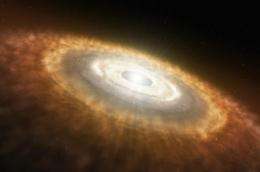Exoplanets Clue to Sun's Curious Chemistry

(PhysOrg.com) -- A ground-breaking census of 500 stars, 70 of which are known to host planets, has successfully linked the long-standing "lithium mystery" observed in the Sun to the presence of planetary systems. Using ESO's successful HARPS spectrograph, a team of astronomers has found that Sun-like stars that host planets have destroyed their lithium much more efficiently than "planet-free" stars. This finding does not only shed light on the lack of lithium in our star, but also provides astronomers with a very efficient way of finding stars with planetary systems.
"For almost 10 years we have tried to find out what distinguishes stars with planetary systems from their barren cousins," says Garik Israelian, lead author of a paper appearing this week in the journal Nature. "We have now found that the amount of lithium in Sun-like stars depends on whether or not they have planets."
Low levels of this chemical element have been noticed for decades in the Sun, as compared to other solar-like stars, and astronomers have been unable to explain the anomaly. The discovery of a trend among planet-bearing stars provides a natural explanation to this long-standing mystery. "The explanation of this 60 year-long puzzle is for us rather simple," adds Israelian. "The Sun lacks lithium because it has planets."
This conclusion is based on the analysis of 500 stars, including 70 planet-hosting stars. Most of these stars were monitored for several years with ESO's High Accuracy Radial Velocity Planet Searcher. This spectrograph, better known as HARPS, is attached to ESO's 3.6-metre telescope and is the world's foremost exoplanet hunter. "This is the best possible sample available to date to understand what makes planet-bearing stars unique," says co-author Michel Mayor.
The astronomers looked in particular at Sun-like stars, almost a quarter of the whole sample. They found that the majority of stars hosting planets possess less than 1% of the amount of lithium shown by most of the other stars. "Like our Sun, these stars have been very efficient at destroying the lithium they inherited at birth," says team member Nuno Santos. "Using our unique, large sample, we can also prove that the reason for this lithium reduction is not related to any other property of the star, such as its age."
Unlike most other elements lighter than iron, the light nuclei of lithium, beryllium and boron are not produced in significant amounts in stars. Instead, it is thought that lithium, composed of just three protons and four neutrons, was mainly produced just after the Big Bang, 13.7 billion years ago. Most stars will thus have the same amount of lithium, unless this element has been destroyed inside the star.
This result also provides the astronomers with a new, cost-effective way to search for planetary systems: by checking the amount of lithium present in a star astronomers can decide which stars are worthy of further significant observing efforts.
Now that a link between the presence of planets and curiously low levels of lithium has been established, the physical mechanism behind it has to be investigated. "There are several ways in which a planet can disturb the internal motions of matter in its host star, thereby rearrange the distribution of the various chemical elements and possibly cause the destruction of lithium. It is now up to the theoreticians to figure out which one is the most likely to happen," concludes Mayor.
More information: This research was presented in a paper that appears in the 12 November 2009 issue of Nature (Enhanced lithium depletion in Sun-like stars with orbiting planets, by G. Israelian et al.).

















